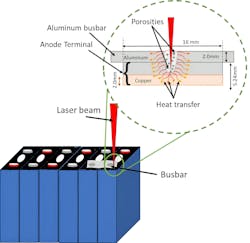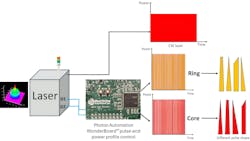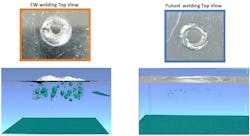Laser pulse shaping enhances busbar welding for EV prismatic batteries
Electric vehicles (EVs) and energy storage rely on robust and efficient battery modules and packs to ensure optimal performance and reliability. Busbar is the critical component, which facilitates electrical connectivity between battery cells. Advances in laser welding technology are improving the structural integrity and extending the lifespan of these essential connections.
Prismatic battery cells are popular for EVs because of their compact design, high energy density, and efficient use of space. Their flat, rectangular shape allows them to fit neatly into battery packs, which reduces wasted space and enables greater energy storage within a smaller footprint and results in a better cell-to-pack ratio than a cylindrical cell. This design also simplifies heat management, which makes prismatic cells a great match for automotive applications.
Why is laser welding busbars to prismatic battery cells important?
Laser welding is increasingly used to join busbars due to its precision and ability to control heat input. But if not properly managed, excessive heat during the welding process can cause several issues. These include the degradation of sealing materials and O-rings, increased internal pressure, and accelerated growth of internal dendrites, which can all reduce a battery’s lifespan.
On the other hand, laser welding aluminum, which is primarily used as busbars and prismatic terminals made from aluminum in battery systems, can create tiny gas bubbles known as porosity. This occurs due to aluminum’s tendency to absorb hydrogen during welding, improper shielding gas, rapid cooling, and keyhole collapse during the welding process. These bubbles weaken the weld by reducing mechanical strength, increasing fatigue susceptibility, and causing issues with thermal conductivity and electrical resistance, all of which negatively impact battery system performance (see Fig. 1).
A recent study1 revealed that 41% of module failures are linked to welding issues, which emphasizes the need for precise control of heat and weld quality to minimize both thermal damage and porosity formation and ensure more reliable and durable battery systems.
Testing pulsing methods for improved aluminum busbar welding
Combining laser pulsing with pulse shaping techniques, especially at the microsecond scale, offers significant advantages over continuous laser welding. In pulsed welding, the laser delivers short, controlled bursts, which allows for better heat management, reduces thermal damage, porosity, cracks, material distortion, and spatter.
Laser pulse shaping further optimizes heat input and material interaction with common shapes like Gaussian, square, and trapezoidal pulses adjusting energy delivery for precision and quality. This approach is particularly effective for materials like aluminum, such as for welding aluminum busbars to lithium-ion battery terminals, because it minimizes the risk of overheating, warping, and spatter, to ensure better weld quality and efficiency.
Compared to continuous methods, using microsecond pulse shaping in laser welding gives better control over distortion and leftover stress, uses less heat, reduces spatter, improves welding strength and quality, and works well for reflective materials. This makes pulsed welding a great choice for jobs like aluminum busbar connections in battery systems, where strong, reliable welds are very important.
At Photon Automation, we tested both continuous-wave (CW) and pulsed laser welding on aluminum busbars. We designed and built the WonderBoard (see Fig. 2) pulse and power profile controller to manage the laser at the microsecond level to allow us to create different pulse shapes. When the laser has features like a combination core-ring profile, we can control the ring and core independently.
We measured the heat levels, tested the strength of the welds, and checked for the porosity level using computed tomography (CT) scans and found:
Improved heat management. The temperature measurements beneath the battery terminal revealed distinct thermal behaviors for CW and pulsed welding. CW welding reached higher peak temperatures (around 90°C) and cooled more slowly, which resulted in heat buildup and potential distortion due to continuous heat application. In contrast, pulsed welding achieved a lower peak temperature (around 80°C) and cooled faster because the heat was applied in controlled bursts. This minimizes heat accumulation and reduces the risk of thermal damage.
Less porosity. Hydrogen trapping is a major concern when welding aluminum, because the metal easily absorbs hydrogen and causes porosity that weakens the weld. Micro-pulsed welding minimizes this issue by controlling heat, preventing the hydrogen trapped inside the keyhole, and reducing keyhole collapse.
Data from CT scans (see Fig. 3) reveal clear differences in porosity between the two welding methods. The CT scans from CW welding show significant porosity, likely caused by poor heat control and trapped hydrogen. Meanwhile, the scans from pulsed welding show much less porosity, indicating better heat regulation and reduced gas entrapment. These findings highlight the superior weld quality achieved with pulsed welding, which offers fewer defects and stronger joints.
Better strength. The tensile test assessed the joint strength and efficiency of both welding methods. Joint efficiency measures how well a welded joint performs compared to the base material, typically expressed as a percentage. A joint with 100% efficiency indicates the weld is as strong as the base material, while lower percentages suggest reduced strength due to factors like weld quality, material fusion, and defects such as porosity.
The test results highlighted significant performance differences between the two methods. Pulsed welding demonstrated superior strength, reaching a load capacity of 3144N with 100% joint efficiency—more than double the 1460N achieved by CW welding. These results confirm that pulsed welding provides better material fusion and creates stronger joints.
Welding matters
Pulsed welding could change how EV batteries are made. It keeps batteries cooler during welding, reduces weak spots, and makes the whole battery pack stronger. As the EV industry grows, adopting better welding methods like pulsed laser welding can lead to safer, longer lasting, and more reliable batteries. With this technology, car makers can build EVs that are more efficient and eco-friendlier, which will help move us toward a greener future.
REFERENCE
About the Author
Najah George
Najah George is senior director of R&D at Photon Automation (Greenfield, IN).
William A. Huffman Jr.
William A. Huffman Jr. is CEO at Photon Automation (Greenfield, IN).
Michael A. Dupont
Michael A. Dupont is the Laser Applications Lab manager at Photon Automation (Greenfield, IN).
Jack Meranda
Jack Meranda is a laser technician at Photon Automation (Greenfield, IN).
David Stucker
David Stucker is the Laser Applications manager at Photon Automation (Greenfield, IN).


